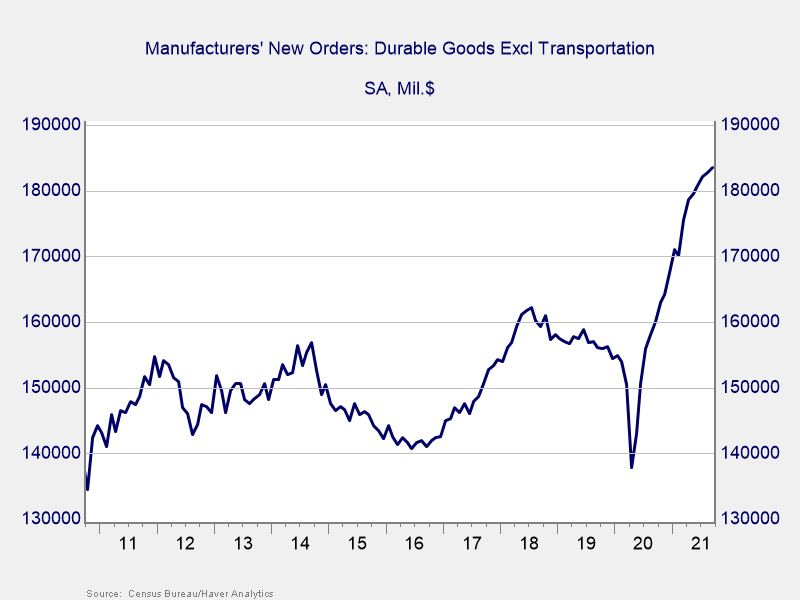Sweet October for Markets
Markets rebounded from September’s pullback with strong results in October, driven by improving economic conditions and a better-than-expected start to earnings season. The Dow Jones Industrial Average gained 5.93 percent, while the S&P 500 saw a 7.01 percent gain. The Nasdaq Composite led the way with a strong 7.29 percent return. These positive results helped all three indices to record highs.
Equities were supported by improved earnings growth. As of October 29, with 55 percent of companies reporting actual earnings, the third-quarter earnings growth rate for the S&P 500 was 37.5 percent, according to Bloomberg Intelligence. At the start of earnings season, analysts had estimated a more modest 28.4 percent increase.
Equity markets also saw solid technical support. All three major indices remained well above their respective 200-day moving averages throughout the month, marking 16 consecutive months with all three indices finishing above trend, an encouraging signal that investors remain confident.
International markets also saw positive results in October, but returns were muted compared with U.S. markets. The MSCI EAFE Index gained 2.46 percent during the month while the MSCI Emerging Markets Index recorded a 1 percent gain.
Fixed income markets experienced turbulence. The Bloomberg U.S. Aggregate Bond Index declined 0.03 percent in October, while the Bloomberg U.S. Corporate High Yield Index recorded a 0.17 percent loss.
Medical Risks Recede
The average number of daily new COVID-19 cases declined throughout the month, finishing at the lowest level since late July. We also saw similar improvements in hospitalizations and deaths. The improving public health picture was driven by increased vaccination levels throughout the country.
Although another wave of infections is possible as we enter winter, the worst is likely behind us as we continue to see improvements on the public health front.
Economy Continues to Grow
Economic reports showed continued economic growth. We saw consumer confidence stabilize, as the Conference Board Consumer Confidence Index recorded a surprise gain for the first time since June. Consumers continued to spend, with September retail sales and personal spending reports showing ongoing growth.
Business confidence and spending reports also showed continued growth. As shown in Figure 1, core durable goods orders have increased notably this year and are well above pre-pandemic levels.
Figure 1. Manufacturers’ New Orders

Businesses have invested in new equipment and workers throughout the year to meet high levels of pent-up consumer demand. This increased spending has been a tailwind for the economic recovery, signaling high levels of confidence from business owners that the current economic expansion is here to stay.
Housing has shown notable improvement throughout the pandemic. Home builder confidence rebounded swiftly after initial lockdowns ended last year and remains in healthy expansionary territory. Existing home sales increased 7 percent in September and reached their highest level since January.
Despite Progress, Risks Remain
We continue to face political uncertainty, as Congress and the current administration negotiate over a large infrastructure spending bill. The continued uncertainty has the potential to weigh on sentiment and markets. In addition, while Congress was able to avoid a government shutdown and debt ceiling-related default in October, we may face a similar situation in December unless another agreement to raise or suspend the debt ceiling is reached.
We may also face uncertainty from the Federal Reserve (Fed), which is widely expected to announce plans to taper asset purchases at its November meeting. The Fed has purchased $120 billion per month in Treasury and mortgage-backed securities throughout the pandemic but is expected to start gradually removing this supportive policy in the months ahead.
International risks remain as well, as seen by continued concerns surrounding the slowdown in China and the country’s troubled property development sector.
Ultimately, the economy continued to show signs of solid growth in October, and the most likely path forward remains continued growth in the months ahead. Although risks remain for the economy and markets, the worst of the medical risks appear to be behind us. Looking ahead, turbulence is possible as we finish the year, so a well-diversified portfolio remains the best path forward for most. As always, if you have concerns, please reach out to us to discuss your financial plan.
All information according to Bloomberg, unless stated otherwise.
Disclosure: Certain sections of this commentary contain forward-looking statements based on our reasonable expectations, estimates, projections, and assumptions. Forward-looking statements are not guarantees of future performance and involve certain risks and uncertainties, which are difficult to predict. Past performance is not indicative of future results. Diversification does not assure a profit or protect against loss in declining markets. All indices are unmanaged and investors cannot invest directly into an index. The Dow Jones Industrial Average is a price-weighted average of 30 actively traded blue-chip stocks. The S&P 500 Index is a broad-based measurement of changes in stock market conditions based on the average performance of 500 widely held common stocks. The Nasdaq Composite Index measures the performance of all issues listed in the Nasdaq Stock Market, except for rights, warrants, units, and convertible debentures. The MSCI EAFE Index is a float-adjusted market capitalization index designed to measure developed market equity performance, excluding the U.S. and Canada. The MSCI Emerging Markets Index is a market capitalization-weighted index composed of companies representative of the market structure of 26 emerging market countries in Europe, Latin America, and the Pacific Basin. It excludes closed markets and those shares in otherwise free markets that are not purchasable by foreigners. The Bloomberg Aggregate Bond Index is an unmanaged market value-weighted index representing securities that are SEC-registered, taxable, and dollar-denominated. It covers the U.S. investment-grade fixed-rate bond market, with index components for a combination of the Bloomberg government and corporate securities, mortgage-backed pass-through securities, and asset-backed securities. The Bloomberg U.S. Corporate High Yield Index covers the USD-denominated, non-investment-grade, fixed-rate, taxable corporate bond market. Securities are classified as high-yield if the middle rating of Moody’s, Fitch, and S&P is Ba1/BB+/BB+ or below Authored by Brad McMillan, CFA®, CAIA, MAI, managing principal, chief investment officer, and Sam Millette, manager, fixed income, at Commonwealth Financial Network®. © 2021 Commonwealth Financial Network®





